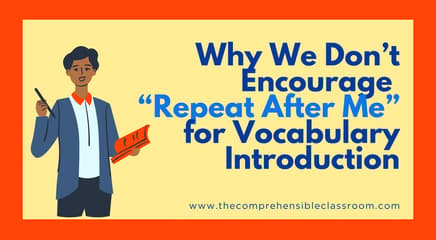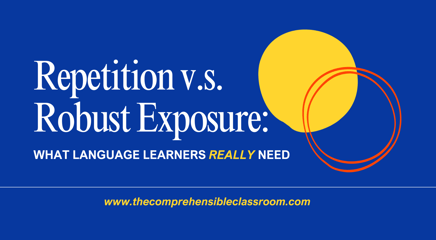Have you ever wanted to teach your students about a topic but didn’t think you could do it in the target language? Maybe you weren’t sure how the topic lined up with the grammar and vocabulary you were currently studying, or maybe you weren’t sure how to present the topic in a way students would be able to understand with their current level of proficiency. Every language teacher wants to be able to teach their students about meaningful topics, but figuring out how isn’t always easy.
Authentic communication can happen in the classroom when language teachers take steps to ensure that students are truly comprehending. When we unlock authentic communication, students not only acquire language, but experience the full benefits of real-life language use: connection, learning, and entertainment.
If you’re a language teacher seeking to make your target language use more comprehensible, you’ve come to the right place. Let’s talk about one of my favorite tools for supporting comprehension: processing questions.
What is a processing question?
A processing question is a question that helps the listener process language and information. In other words, it helps students take in an idea and also make sense of the language being used to communicate the idea.
A processing question is a lower cognitive question that references a previous statement. They are closed, recall questions. This means that there is a fixed set of possible answers, and they are asking about information that has just been shared. When you use a processing question, students should already know the answer… because you just said it!

Let’s look at an example:
Statement: Dolphins live in the ocean.
Processing Question: Do dolphins live in the ocean?
You see, I made a statement (“Dolphins live in the ocean”), and then I asked a question about the statement (“Do dolphins live in the ocean?”). It was a closed question about something I had just said. It’s an easy question to get right, and it should be!
Here are two more examples:
Statement 1: Apples grow on trees.
Processing Question: Do apples grow on trees or on bushes?
Statement 2: I love to eat ice cream.
Processing Question: What do I love to eat?
Processing questions support language acquisition
Language acquisition doesn’t happen when we simply hear language being used around us. Our brains need to create a meaningful link between the forms contained within language and their meanings.
Stephen Krashen said it like this: “We acquire language when we understand messages; when we understand what people tell us and when we understand what we read.”
“We acquire language when we understand messages; when we understand what people tell us and when we understand what we read.”
(The same is true for understanding what we view, in the case of signing.)
He did not say, “We acquire language when people talk to us and when we read,” because it’s the comprehension piece that makes acquisition possible.
If we want our students to acquire the target language, we need to help them understand it. (Curious as to how deeply they need to understand it? Check out the video in this blog post.)
Processing questions can help with comprehension and, consequently, acquisition. Here’s how:
Slowed pace:
Processing questions slow down the flood of language. If you make five statements in a row, each one floods students with new information and more words to process. Placing processing questions between statements with new information will give students time to park their attention on ONE piece of information and ONE set of words and patterns at a time, giving them more time to process everything coming in.
Focused Attention:
Our brains are really efficient, and they will often only notice what they need to in order to make sense of a message coming in. When the message coming in contains many bits of language, especially unfamiliar bits of language, learners can experience a deer in the headlights moment. There is so much coming at them, they don’t know where to begin!
By asking a processing question about a piece of the statement that YOU want students to focus on, you’re forcing their brain to attend to that piece while helping them to move out of that moment of feeling stunned.

Processing questions are also useful for focusing attention because many statements contain redundancies. In Latin, for example, the verb ending carries information about the subject. If the subject is also explicitly stated in the sentence, the brain doesn’t need to process the verb ending in order to make sense of the statement. Strategic processing questions can once again force the brain to attend to bits of language that it might otherwise skip over.
Enhanced Comprehension
Many processing questions also serve to enhance comprehension by clarifying meaning. Let’s look at this example:
Statement: Dogs have two eyes.
Question: Do dogs have two eyes or four eyes?
Feedback: Dogs do not have four eyes. They have four legs, but not four eyes. They have two eyes.
Especially when words are unfamiliar to students, contrasting words with other options through either/or questions can help students to feel confident about their interpretation of the meaning.
Repetition:
The fact that students do understand something doesn’t mean that they will acquire it. Language acquisition is very complex, and whether or not something gets built into the internal linguistic system is affected by a number of factors.

One of these is repetition!
Usually, we need repeated, comprehended exposure to a word or pattern in order to acquire it. More than that, we need repeated, comprehended exposure to that item in a variety of contexts in order for our brains to process the many ways that feature fits into the bigger linguistic system. What words can it be used with? What are its different forms? What contexts can it be used in?
Processing questions create repetition. Students are exposed to the same words in the original statement, the question, and likely a feedback statement (ex: Yes! That’s right! Dolphins live in the ocean!). That’s three exposures instead of just one. And, those exposures happen in different contexts: statements and questions, and there are other variables depending on what the feedback looks like.
Processing questions help memory
In acquisition-focused classes, teachers aren’t spending their time teaching students about grammar rules in vocabulary. Instead, they’re using language to study content in a way that students can understand. The content they study might be
- Students - Learning about each other through Weekend Chat, Calendar Talk, Special Person Interview, Personalized Questions and Answers, Card Talk, etc.
- Non-fiction - Studying people, places, practices, products, and perspectives student’s own cultures, the target cultures, and other regional and world cultures.
- Fiction - Stories, short films, games, jokes, etc.
Language teachers likely aren’t assessing students on their retention of the information that they study in class. It’s a language class, after all, and so assessments and students’ grades should evaluate and communication information on their progress toward linguistic proficiency. (Dual language programs are an exception!) But there are steps that language teachers can take to help their students learn and remember the important non-linguistic information studied in class. You guessed it – processing questions can help with this, too.
Repetition and Rehearsal:
Asking processing questions is retrieval practice. Asking students to recall information you’ve just shared (recalling from short term memory) mimics the actions their brains will need to take when recalling it from their long-term memory. They are not just passively receiving input; they are actively reconstructing it. This act of retrieval strengthens memory traces, making it more likely that the information will move from working memory to long-term memory.

Furthermore, retrieval through processing questions functions as a type of rehearsal, which is a cognitive mechanism that helps solidify learning. When students recall and confirm meaning, they engage in a low-stakes, high-success interaction that builds confidence and reinforces comprehension. It’s just like rehearsing for a play! The more you rehearse, the more confident and capable you become.
5 tips for using processing questions effectively
Processing questions are lower cognitive, closed questions designed to prompt recall of information already shared. They aren’t meant to generate new information or encourage lengthy discussion, but to reinforce understanding. Here’s how you can integrate them into your teaching:
1. Frame the Right Questions
Focus on questions that circle back to a statement you’ve made. For example, after stating, “We acquire language when we understand messages,” you might ask:
- “Do we acquire language when we listen to messages?”
(Expected answer: No, we acquire language when we understand messages.) - “How do we acquire language?”
(Expected answer: We acquire language when we understand messages.)
These closed questions help students focus on key points without overwhelming them with higher-order thinking tasks.
2. Break Down Complex Input
When presenting a flood of new language or multiple ideas in one sentence, use processing questions to isolate individual pieces of information. This strategy is especially effective for beginners or when dealing with longer, more complex utterances.
3. Give Students Think Time
Processing questions naturally slow the pace of your lesson, offering your students a moment to reflect on what they’ve heard. That pause can be crucial for deep processing and forming lasting connections between the language and its meaning.
4. Build Student Confidence
By using processing questions that have clear, factual answers, you help boost your students’ confidence. Every time a student correctly recalls or identifies key information, they build trust in their own abilities. Processing questions are easy to get right, so they are BIG confidence builders! This confidence in their capabilities lowers their stress levels and the affective filter, which hinders acquisition.
5. Use Question Sequences
Rather than asking a single processing question, consider stretching your questions into a sequence. For example:
- Make a statement: “Brandon wants a dog.”
- Ask a confirmation question: “Does Brandon want a dog?”
- Provide feedback by restating and elaborating on the key fact: “Yes, Brandon wants a dog. He wants a big dog.”
This triadic approach—initiation, response, and feedback—reinforces the content and ensures repeated exposure to the language.
Not everything needs processing support
When planning your lesson, be strategic with your processing questions. Not every piece of information requires a processing question—save them for moments when the language is new, complex, or essential for understanding the core message.

Use processing questions to:
- Focus student attention on unfamiliar vocabulary or sentence structures.
- Encourage repetition without redundancy.
- Support unconscious language acquisition while keeping the lesson focus on real-life topics and authentic content.
- Support memory of new facts and information.
Remember, the goal is to help your students not only understand the language, but also to feel confident and engaged while doing so.

More processing!
If you’re ready to dive deeper into strategies that work in real classroom settings, I invite you to get more training from The Comprehensible Classroom. And if you are hooked on processing questions and want to tap into their benefits for your students, sign up for Garbanzo! All of the lessons are written with processing questions embedded between new content.




